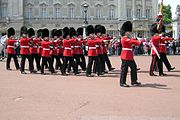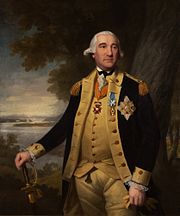
The Queen's Guard on parade outside Buckingham Palace
A Foot drill is an essential part of the training regimen of organized military and paramilitary elements worldwide. "Foot drill" or "Drill" stems from time since antiquity when soldiers would march into battle, be expected to gather in a formation, and react to words of command from their commanders once the battle commenced. Much of the drill done today is either ceremonial, or implemented as a core part of training in the Armed Forces. Military discipline is enhanced by drill, as it requires instant obedience to commands.
Drill proved useful when marching formations of soldiers cross-country. For example, officers could form men from an eight-wide route march formation to a two-wide formation for passing through gates and other narrow passages, without losing time or cohesion. Drill was used to efficiently maneuver formations around and through obstacles.
Drill was often used as a forerunner to great battles; during them it justified itself. It was also utilized after battles, where quick restoration of the corporate unity of an element was required.
Drill in history[]

Nicholas I of Russia was nicknamed a drill-master on account of his devotion to mindless drill
Vegetius composed his treatise on the Roman Empire's military, De Re Militari, at some point between 378 and 390 CE during the reign of Valentinian II in the Western Roman Empire. This work consists of three separate, yet related books, the first establishing methods of training and selecting new recruits, the second and third books a continuation of the first, describing in detail training and discipline matters as they pertained not only to the troops, but also to the leadership in times of training and battle, as well as positing an argument for reforms in the army.
Within these books can be found a detailed guide for drill of the army. Among these drills, the military step describes how initial training should consist of "constant practice of marching quick and together. Nor is anything of more consequence either on the march or in the line than that they should keep their ranks with the greatest exactness. For troops who march in an irregular and disorderly manner are always in great danger of being defeated. They should march with the common military step twenty miles in five summer-hours, and with the full step, which is quicker, twenty-four miles in the same number of hours. If they exceed this pace, they no longer march but run, and no certain rate can be assigned." [1]
Drill and ceremony in the Order Of Malta[]
Within the Order of Malta Ambulance and Cadet Corps in Ireland, there is a tradition of Foot Drill through the ranks. Like armies all over the world there is a high standard of Foot Drill, and they hold competitions both in First Aid, Home Nursing and Foot drill once a year for the Cadet Corps and Ambulance corps to keep standards at a high level.Some of the cadet corps and ambulance corps learn their foot drill in Gaeilge.
Origins of modern drill in the U.S. Military[]

Baron von Steuben
United States military drill originated in 1778, as part of a training program implemented by Baron Friedrich von Steuben to improve the discipline and organisation of soldiers serving in the Continental Army. The following year Baron von Steuben, by then a Major General and the Inspector General of the Continental Army, wrote the Army's first field manual, "The Regulations for the Order and Discipline of the Troops of the United States", which has come to be more commonly known as the "Blue Book". The methods of drill that von Steuben initiated remained largely unchanged between their inception and the time of the American Civil War. One major change to come about since that time is that troops now march at a cadence of 120 steps per minute, instead of the original 76 steps per minute at the time of the American Revolution.
The stated aim of drill is to "enable a commander or noncommissioned officer to move his unit from one place to another in an orderly manner; to aid in disciplinary training by instilling habits of precision and response to the leader’s orders; and to provide for the development of all soldiers in the practice of commanding troops." [2]
Between branches of the military, as well as between the military forces of various countries, the methods of drill will vary. In the United States Armed Forces, the basis of drill procedures can be traced to von Steuben's "Blue Book".
U.S. Army drill procedures[]
The procedures for drill in the modern United States Army are set forth in Army Field Manual (FM) 3-21.5, Drill and Ceremonies.[2] Part one of the field manual contains guidelines for the different aspects of drill;
- Drill Instructions
- Commands and The Command Voice
- Individual Drill
- Individual Drill with Weapons
- Squad Drill
- Platoon Drill
- Company Drill
- Battalion and Brigade Drill
Distribution of the field manual is currently unlimited, and the manual can easily be found on the internet.
Drill commands[]

US Army Drill Team performs at Twilight Tattoo. (Photo courtesy of the U.S. Army)
Most of the commands in modern drill are separated into two distinct parts; the Preparatory Command, and the Command of Execution. The preparatory command indicates to the person performing the movement that a command of execution is soon to follow - and which action to perform.. The command of execution indicates the movement to be performed. An example of this is the command "Present ARMS", which is utilized to command a group of soldiers to render a salute. In this command, the word "Present" is the preparatory command, whereas the following word, "ARMS" is the command of execution. The movement is performed immediately upon reception of the execution command.
When issuing the command, vocal inflection is varied so that the preparatory command is given less emphasis, and the most emphasis is placed on the command of execution. There is usually a slight hesitation between each element of the command, about the duration of a finger snap. Other examples of the two-part command structure are:
- "Right Flank...MARCH"
- "Order...ARMS"
- "Left Shoulder...ARMS"
- "Stand at...EASE"
- "About...Face"
Drill movements[]
All drill movements are performed from the base position of Attention. In this position, the person performing the movement stands straight, arms down and slightly flexed, fingers curled into the palm, thumbs pointed down and placed against the seam of the trouser, and the feet positioned at a forty-five degree angle with heels together. The most common command given by leaders to gather their elements into formations is the command "Fall IN", at which time the person takes their position in the formation and at the position of attention. From this position, almost any other drill command can be executed.
Basic foot drill commands (British Army)[]
Squad, Squad SHUN - Move the soldiers to the position of attention. The chin is raised, with the neck in the back of the collar, chest forced out, arms held by the sides, and the hands forming a fist. The thumb should be forcing down on the index finger, and touching the seam of the trouser. The feet should be angled at 30 degrees, with the heels touching.
Stand at, EASE - Move the soldiers from a position of attention to a 'braced up' position of rest. Stand EASY - Put the soldiers to a position of rest from the STAND AT EASE position
References[]
- ↑ De Re Militari, Book I: The Selection and Training of New Levies
- ↑ 2.0 2.1 US Army FM 3-21.5 Drill and Ceremonies
External links[]
- E-text of English translation of De Re Militari
- Homepage of De Re Militari: The Society for Medieval Military History, an academic association that is concerned about medieval warfare
- An English translation of De Re Militari by Lieutenant John Clarke (1767)
- Army Study Guide.com Pubs and Forms
- Irish Order of Malta web pages
- Sovereign Order of Malta web pages (International)
The original article can be found at Foot drill and the edit history here.